After scoring just once from 61 shots across their last three games, many are shouting for Arsenal to sign a new striker. They scored 88 goals in the Premier League last season, though, so could the answer be closer to home?.
Sunday felt like it summed up Arsenal’s recent struggles. Their FA Cup third round tie against Liverpool saw them create plenty of chances, press well, force mistakes and do almost everything right, except putting the round thing into the rectangular thing.
As a result, Mikel Arteta’s men lost 2-0 and another opportunity to secure silverware was waved off into the distance.
It was the latest in a recent run of games that has seen Arsenal struggle to find the net and pay the price for it.
Their cup defeat to Liverpool made it consecutive home losses by a margin of 2+ goals for the first time since May 2009 (3-1 vs Manchester United, 4-1 vs Chelsea), having also been beaten 2-0 by West Ham in the Premier League on 28 December.
It made it one win in seven in all competitions for Arsenal – their fewest wins over a seven-game period under Arteta – and three defeats on the bounce, having also lost 2-1 at Fulham on New Year’s Eve. In fact, across those three games, Arsenal have scored just one goal from 61 shots, and a total expected goals (xG) value of 6.0, meaning they scored five fewer goals than they should have based on the quality of the opportunities created.
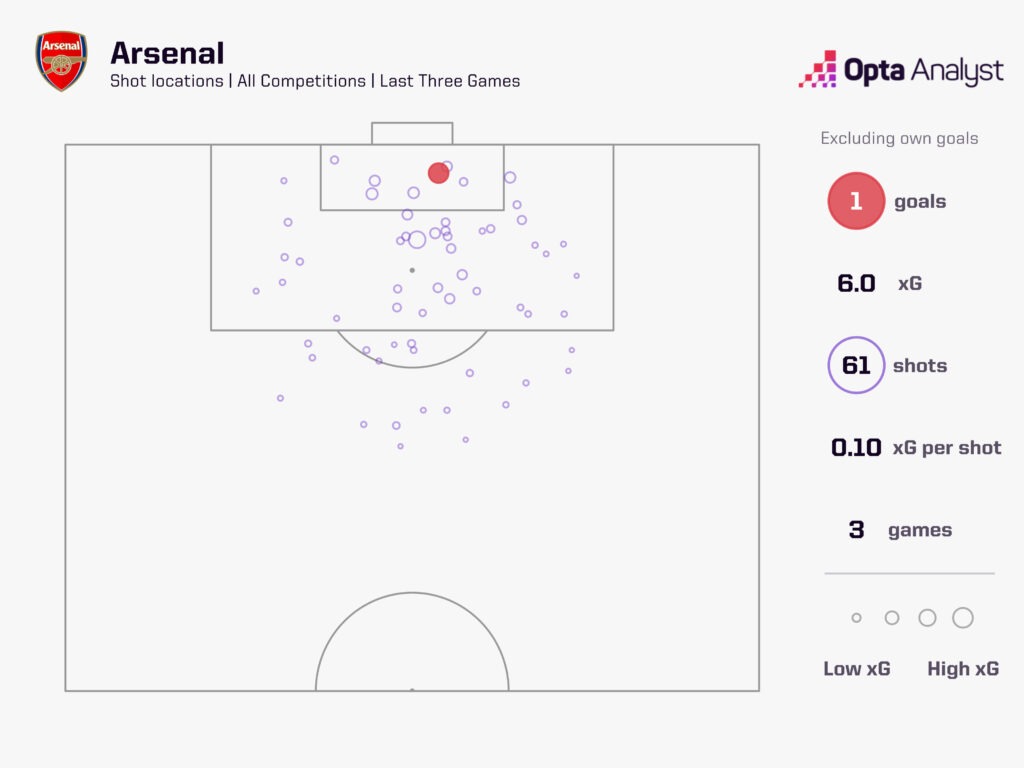
Therefore, the predictable shouts from pundits and Arsenal fans alike at the Emirates Stadium on Sunday was for the club to sign a striker.
Ivan Toney, Dominic Solanke, bring Ian Wright out of retirement; the number of (not entirely serious) solutions that involve new faces being brought to north London are almost endless.
When told that the fans had been demanding a new striker during the game, Arteta said in his post-match press conference: “At the moment it does not look realistic. What my job is, and what we have to do is improve our players and try to get better results with the players we have.
“What I beg from the supporters is that they are behind the team like they have been in difficult moments.”
And as disheartening as it might be for Arsenal fans who want to see a shiny new striker arrive in the January transfer window, Arteta is right.
His job is to improve the players he has, the same ones who collectively scored 88 goals in the Premier League last season, 13 more than the third most (Liverpool) and only six fewer than champions Manchester City, who had Erling Haaland.
While Toney or Solanke might add goals, it’s a bit too easy to assume Arsenal will otherwise keep playing exactly the same way and creating the number of chances they are now if they were to add a different type of striker.
We observed in November that Arsenal had become a little less extravagant going forward but a little more robust overall, though that has deserted them somewhat in recent games.
As well as scoring just once from 61 attempts since Christmas, they have conceded six times from 33 shots faced and an overall xG against of 3.3.
From an attacking sense, it could simply be that Arsenal have reverted to the mean.
Last season in the Premier League they scored their 88 goals from an xG of 72.3, scoring about 16 goals more than they should have.
This season they have scored 37 from an xG of 37.2, almost exactly what they should have.
If you just look at non-penalty goals, though, things do look a bit more concerning.
Arsenal have already scored twice as many penalties in the Premier League this season (six) as they did in the whole of last season (three), meaning they have scored just 31 non-penalty goals in their 20 games.
That’s an average of 1.55 non-penalty goals per game, compared to last season’s 2.24.
Arsenal’s chance creation hasn’t really been impacted, though. In fact, they are averaging slightly more shots per game this season (16.3) in the league than they did last season (15.6), and their average xG per game is only very narrowly lower (1.86) than last season (1.9).
So it’s not as if they are creating significantly lower quality chances, they just simply aren’t converting them as often.
We looked only last week at how giving Bukayo Saka a rest could be a solution for the Arsenal boss, though yet again it was the England man who started against Liverpool and Gabriel Martinelli was the one who dropped to the bench, with Reiss Nelson coming in.
Arteta was able to rely on both Saka and Martinelli regularly finding the net last season, scoring 14 and 15 Premier League goals respectively, while Martin Ødegaard also hit 15.
All three have seen their efficiency in front of goal reduce considerably in 2023-24, though.
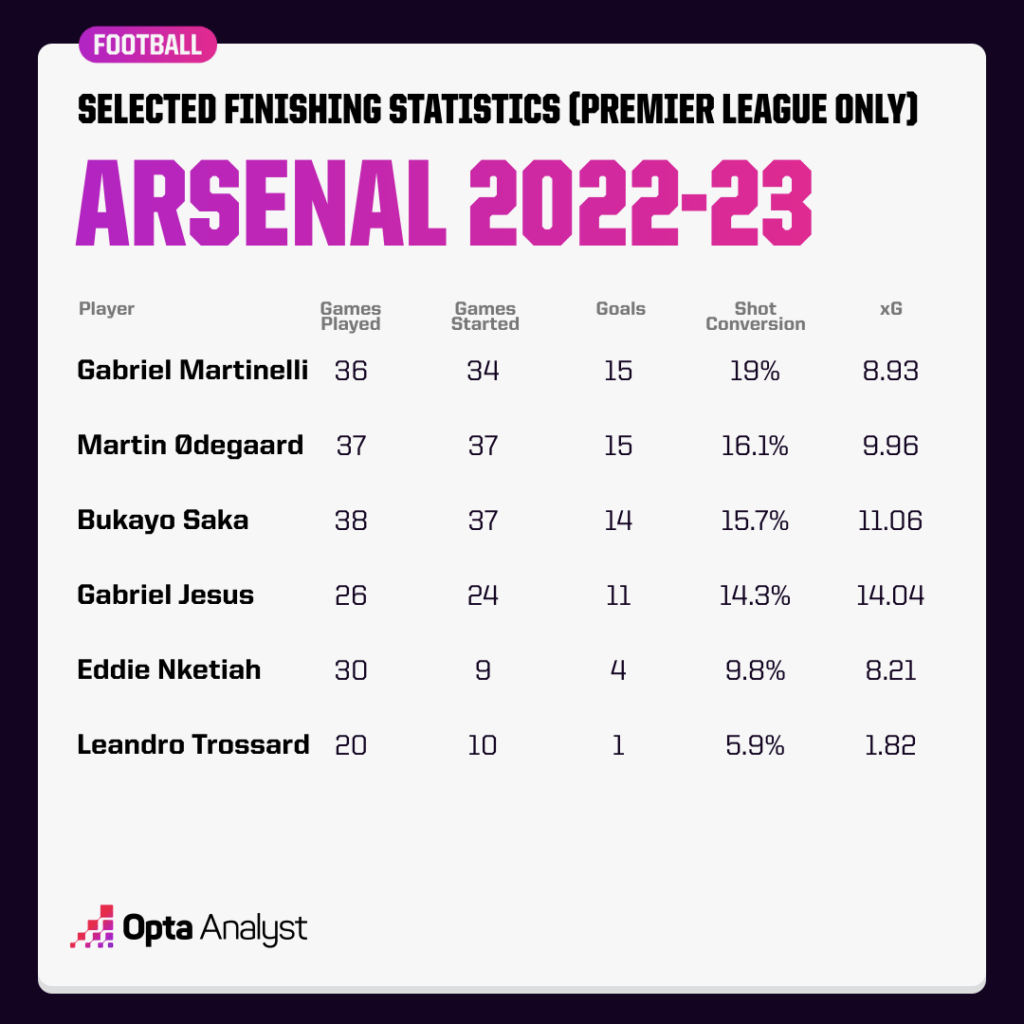
Saka’s 14 league goals in 2022-23 came with a conversion rate of 15.7%, while he scored seven of his 10 big chances (70%). This season, Saka has a conversion rate of 12.2%, and though he has already had more big chances than he did in the whole of last season (11), he has only scored four (36.4%).
Martinelli’s drop is far greater, going from a 19% shot conversion rate last season in the Premier League to 6.1% this, scoring just twice from 33 shots, and he has only had three big chances (scoring one), having had 16 last season (scoring 10).
Ødegaard has slipped from a 16.1% conversion rate to just 10.3% but has scored two of his three big chances.
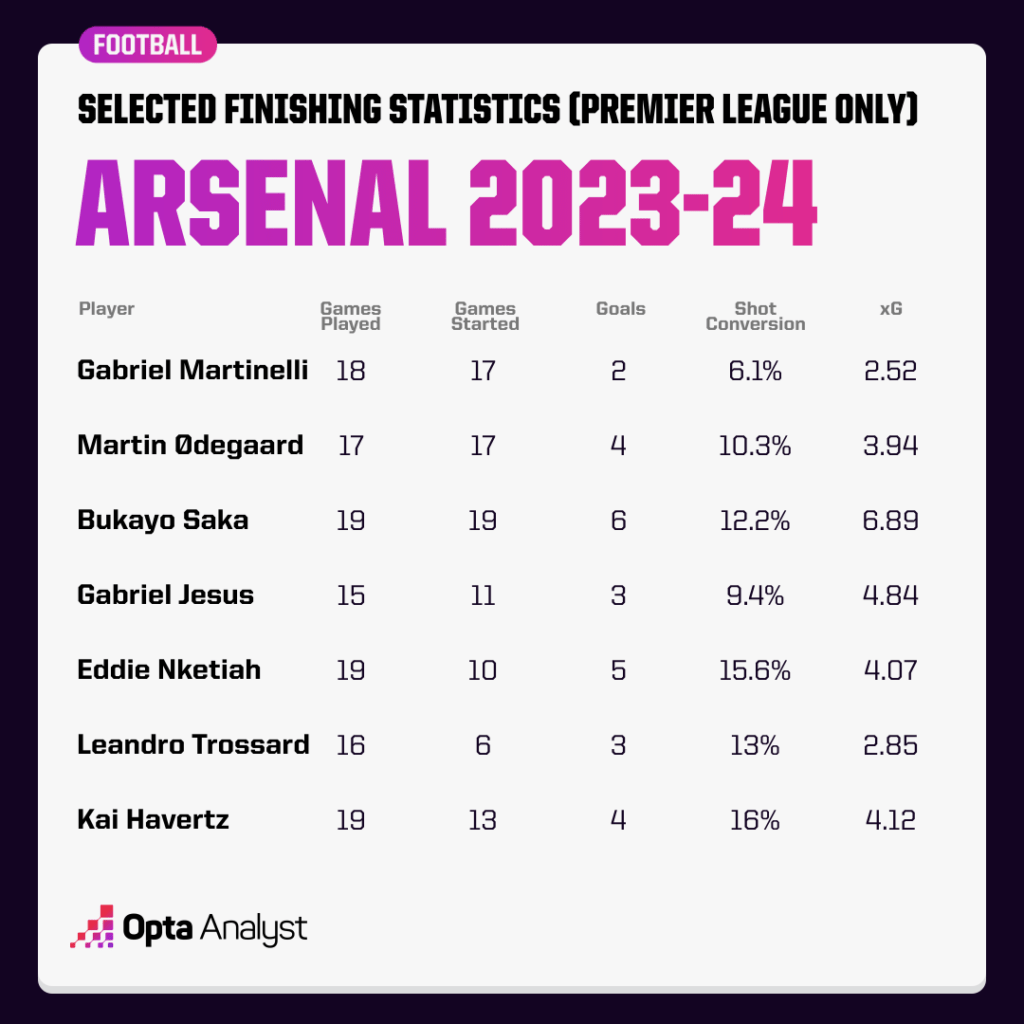
Leandro Trossard was an interesting addition from Brighton last January, and he provided an outstanding 10 assists in the second half of the 2022-23 Premier League season, though he scored just once from 17 shots.
The Belgian wide forward has three league goals this season, but just one assist.
Whether that is down to a change in Trossard’s game or just a result of poor finishing from his teammates is up for debate, but he is another attacking player whose output has noticeably dipped.
The main debate seems to be around the central strikers, however.
Gabriel Jesus was hailed as an important addition when he arrived from Man City in the summer of 2022, and his impact last season was impressive.
He scored 11 league goals in 26 games and had a respectable shot conversion rate of 14.3%, while he had the highest xG of all of Arsenal’s forwards (14) and also produced six assists.
This season he’s converted just 9.4% of his shots, with three goals in 15 games from an xG of 4.84.
After allowing Folarin Balogun to leave for Monaco in the summer, Eddie Nketiah is probably the closest Arsenal have to the out-and-out goalscoring number nine the fans are clamouring for, but he had a conversion rate of just 9.8% in the Premier League last season, and put away only four of his 15 big chances (26.7%).
He’s actually upped his overall conversion rate to 15.6% this season and scored three of his seven big chances (42.9%). Arteta started Nketiah in nine of Arsenal’s first 11 Premier League games this season but has given him just one start since Jesus returned, which was last time out in the defeat at Fulham.
That may be primarily due to Jesus being more creative than Nketiah last season, with the Brazilian averaging 1.35 chances created per 90 minutes compared to Nketiah’s 0.76. That gap has widened this season, with Jesus creating 1.63 chances per 90 to Nketiah’s 0.65.
Kai Havertz’s numbers are skewed by the fact he has played several games in midfield since arriving from Chelsea, but he has scored just four goals from 19 Premier League games and is the only attacking player to start in the league this season and average under two shots per 90 (1.92).
The Germany international tried to impose himself when he started up front against Liverpool on Sunday, having six shots, the most by an Arsenal player in an FA Cup game without scoring since Olivier Giroud against Hull City in the 2014 final (six).
Havertz hit the target with only two of them, though, while he completed 12 of just 18 passes and won only two of 14 duels contested.
Having said that, Nketiah came on in the 81st minute and had just one touch of the ball. In fact, of every Arsenal player to have featured in at least five Premier League games this season, no-one has averaged as few touches per 90 as Nketiah’s 32.7.
He’s the only outfield player to average fewer touches than goalkeeping pair David Raya (37.6) and Aaron Ramsdale (32.8).
Let’s compare with Ivan Toney’s Premier League numbers from last season. The Brentford striker scored 20 goals in 33 games, six of which were penalties, with an overall shot conversion rate of 21.3%, averaging 41 touches per 90 (of Arsenal forwards only Nketiah has averaged fewer this season), while also scoring 17 of his 33 big chances (51.5%).
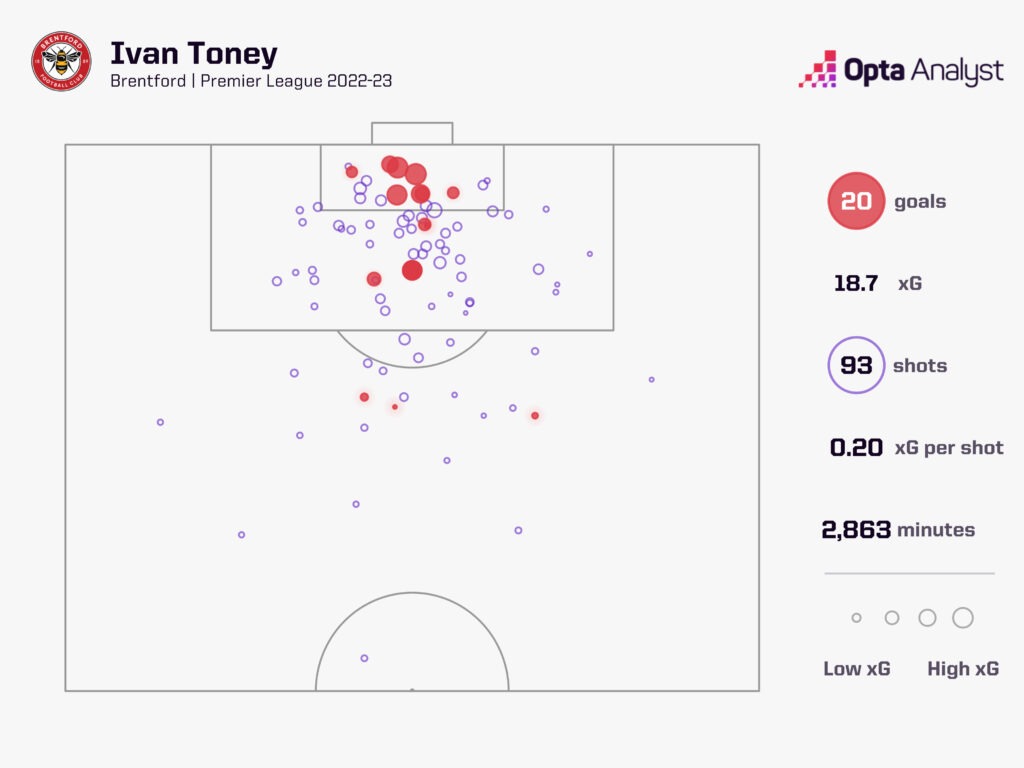
You can therefore understand why there is such a clamour for someone of his profile at Arsenal.
When it feels like nothing will go in for you, the natural reaction is to look to someone who has history of putting away a healthy amount of his chances.
It does seem like having a striker of that type would require a compromise elsewhere, though, especially given how different Brentford play to Arsenal.
Looking at last season’s stats in the Premier League off the ball, Jesus averaged 1.5 tackles per 90, more than twice as many as Toney’s 0.7, while the former Man City man made 13 pressures in the final third per 90 (Toney 9.6) 2.7 pressures in the final third resulting in a turnover per 90 (Toney 1.8), and 1.2 pressures in a team press resulting in a turnover per 90 (Toney 0.6).
That’s not to say Toney couldn’t adapt, but doing so could also impact on his output in front of goal.
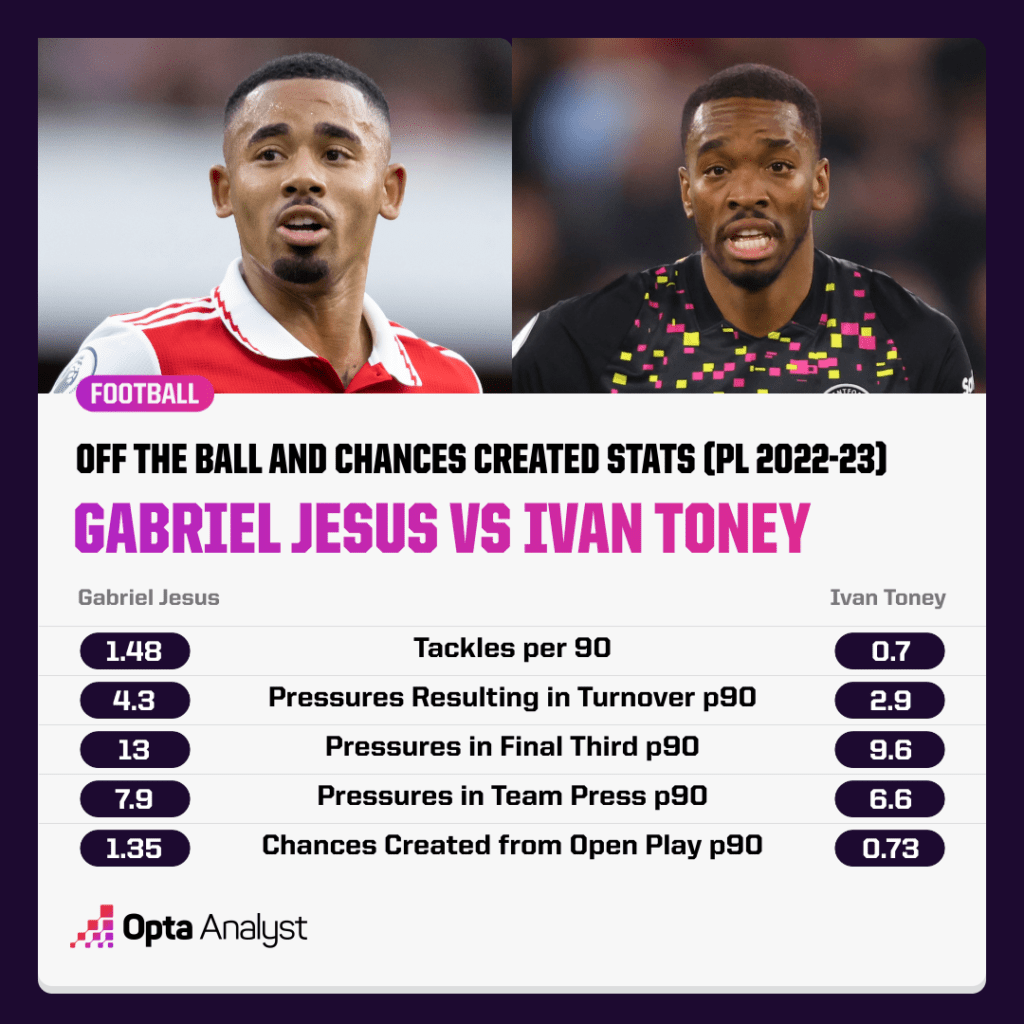
Arsenal would also have the issue of finding the significant money it would take to pry Toney from the Gtech Community Stadium, which would likely be the case for any other striker of the required level in the January transfer window.
Arteta is right that he needs to solve this issue himself. That’s what the best managers do, and while it’s easier said than done, the fact of the matter is that he has a group of players available to him who scored more than enough goals only last season.
Find a way to get the likes of Saka, Martinelli and Ødegaard firing again, and all of a sudden, sticking with what he knows makes a lot more sense.
